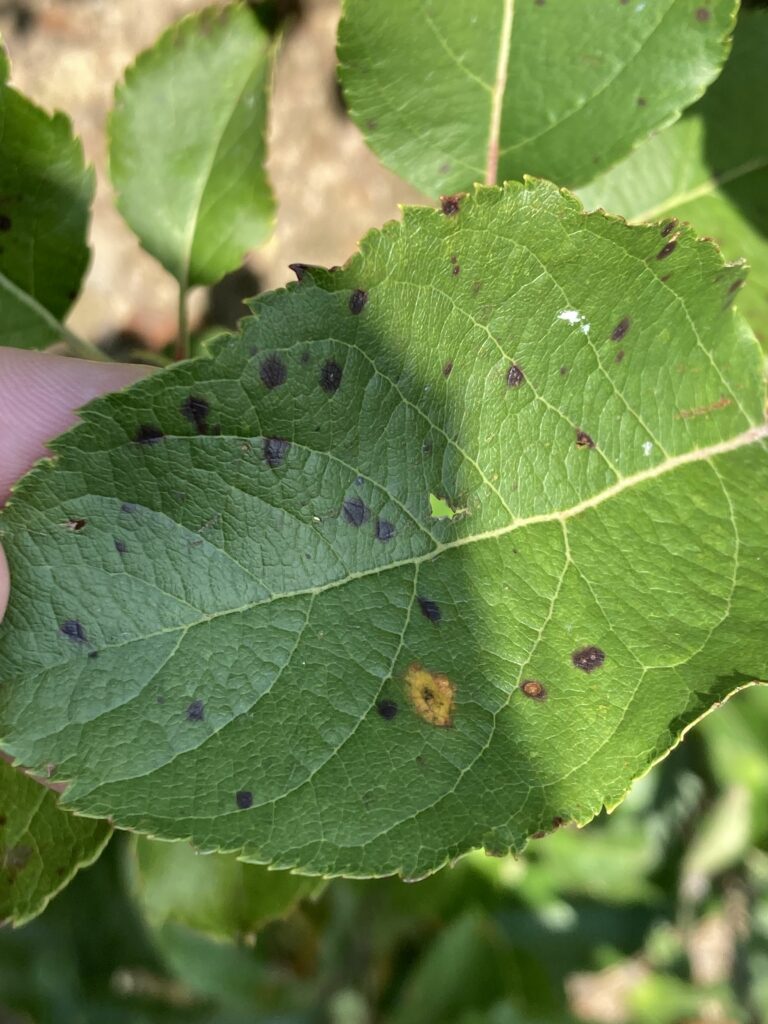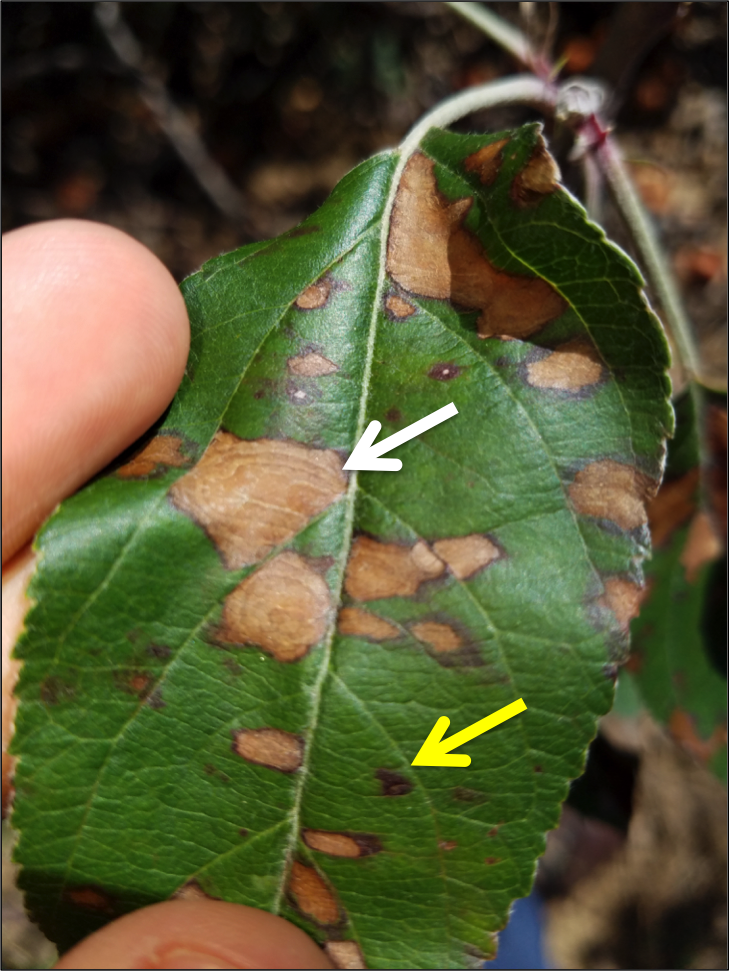Apple Disease Update: Week of July 26, 2021
go.ncsu.edu/readext?811370
en Español / em Português
El inglés es el idioma de control de esta página. En la medida en que haya algún conflicto entre la traducción al inglés y la traducción, el inglés prevalece.
Al hacer clic en el enlace de traducción se activa un servicio de traducción gratuito para convertir la página al español. Al igual que con cualquier traducción por Internet, la conversión no es sensible al contexto y puede que no traduzca el texto en su significado original. NC State Extension no garantiza la exactitud del texto traducido. Por favor, tenga en cuenta que algunas aplicaciones y/o servicios pueden no funcionar como se espera cuando se traducen.
Português
Inglês é o idioma de controle desta página. Na medida que haja algum conflito entre o texto original em Inglês e a tradução, o Inglês prevalece.
Ao clicar no link de tradução, um serviço gratuito de tradução será ativado para converter a página para o Português. Como em qualquer tradução pela internet, a conversão não é sensivel ao contexto e pode não ocorrer a tradução para o significado orginal. O serviço de Extensão da Carolina do Norte (NC State Extension) não garante a exatidão do texto traduzido. Por favor, observe que algumas funções ou serviços podem não funcionar como esperado após a tradução.
English
English is the controlling language of this page. To the extent there is any conflict between the English text and the translation, English controls.
Clicking on the translation link activates a free translation service to convert the page to Spanish. As with any Internet translation, the conversion is not context-sensitive and may not translate the text to its original meaning. NC State Extension does not guarantee the accuracy of the translated text. Please note that some applications and/or services may not function as expected when translated.
Collapse ▲ Leaf defoliation on apple trees has begun in Western North Carolina, but unfortunately it’s not quite autumn. Rather, the fungal pathogens causing Marssonina leaf blotch and Glomerella leaf spot rather enjoy the hot, humid, and wet conditions over the past few weeks throughout the area and are creating some rather spectacular symptoms on apple foliage throughout the region. Even if the spring freezes left your trees void of apples, it’s important that you maintain a fungicide program to limit inoculum buildup in the orchard and to reduce winter injury and poor fruit set next season.
Leaf defoliation on apple trees has begun in Western North Carolina, but unfortunately it’s not quite autumn. Rather, the fungal pathogens causing Marssonina leaf blotch and Glomerella leaf spot rather enjoy the hot, humid, and wet conditions over the past few weeks throughout the area and are creating some rather spectacular symptoms on apple foliage throughout the region. Even if the spring freezes left your trees void of apples, it’s important that you maintain a fungicide program to limit inoculum buildup in the orchard and to reduce winter injury and poor fruit set next season.
The afternoon showers we’ve been experiencing throughout the region over the past few weeks means that wetting events (needed for infection and symptom development) have aligned with optimal temperatures for both the Colletotrichum fungal pathogens causing GLS and bitter rot as well as for Marssonina coronaria, the causal fungal pathogen of Marssonina leaf blotch. The trick to controlling these diseases in a year with a below-average crop is to aim for minimizing symptom development rather than keeping foliage completely absent of disease. Cultural management paradigms in late autumn or during dormancy such as flail mowing and urea applications will help to reduce levels of inoculum for the next season anywhere from 33 to 90%. Thus, low disease incidence this year plus a solid leaf management program following leaf drop should help keep disease pressure down next season. Since GLS and Marssonina may look similar I’ve compared foliar symptoms of both diseases below
Marssonina Leaf Blotch (MLB) vs Glomerella leaf spot Symptoms (GLS)
 Early symptoms of MLB often appear as irregularly shaped small purple spots, but may also be red to brown colored with a purple border.
Early symptoms of MLB often appear as irregularly shaped small purple spots, but may also be red to brown colored with a purple border.
Early symptoms of GLS (yellow arrow) often appear as irregularly shaped small purple flecks. Unlike MLB, they do not tend to be as numerous or “clumped” together.
 Mature symptoms of MLB often appear as brown blotches on foliage that are surrounded by light green to yellow (chlorotic) tissue. Diffuse strands of fungal structures called acervuli will form. These structures contain asexual spores called conidia that can cause additional infections on leaves and fruit throughout the season. Premature defoliation occurs when disease is severe.
Mature symptoms of MLB often appear as brown blotches on foliage that are surrounded by light green to yellow (chlorotic) tissue. Diffuse strands of fungal structures called acervuli will form. These structures contain asexual spores called conidia that can cause additional infections on leaves and fruit throughout the season. Premature defoliation occurs when disease is severe.
 Mature symptoms of GLS consist of irregularly shaped brown lesions, often with concentric growth rings. Perithecia, fungal structures that also contain spores, form on leaves (usually following defoliation) and can cause additional infections throughout the season. Similar to MLB, leaves will also become chlorotic, although the “green islands”, or spots of green tend to be more prominent with MLB. Similar to MLB, premature defoliation often occurs on poorly managed trees.
Mature symptoms of GLS consist of irregularly shaped brown lesions, often with concentric growth rings. Perithecia, fungal structures that also contain spores, form on leaves (usually following defoliation) and can cause additional infections throughout the season. Similar to MLB, leaves will also become chlorotic, although the “green islands”, or spots of green tend to be more prominent with MLB. Similar to MLB, premature defoliation often occurs on poorly managed trees.
In addition to difference in symptom development, identifying the cultivar in which symptoms occur may also assist in differentiating between the two diseases. GLS symptoms are most commonly observed in Granny Smith or in cultivars with a Golden Delicious parent. While MLB can occur most apple cultivars that I am aware of, I’ve commonly observed the disease in Rome Beauty, Honeycrisp, and several cider apple cultivars.
Fungicides Game Plan for this Week
- If you are not harvesting within the next two weeks, consider a Captan (1/2 rate) + Ziram (3 lb/A), a Captan (1/2 rate) + a FRAC 3 fungicide such as Inspire Super or Cevya (for flyspeck sooty blotch control) OR Captan (3/4 rate) plus ProPhyt (3 to 4 pt/A for flyspeck/sooty blotch control). These options will have good to excellent efficacy against GLS and MLB
- If you are harvesting within the next 10 days or sooner, consider a Merivon (full rate) + Captan (1/2 rate) application. The Merivon will provide extended protection during storage.


